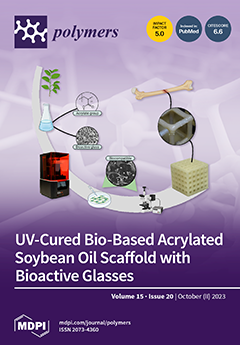The application of photocatalysis technology in environmental pollution treatment has garnered increasing attention, and enhancing the photocatalytic efficiency and recyclability of photocatalysts represents a pivotal research focus for future endeavors. In this paper, polypyrrole titanium dioxide nanocomposite (PPy-TiO
2) was prepared using
[...] Read more.
The application of photocatalysis technology in environmental pollution treatment has garnered increasing attention, and enhancing the photocatalytic efficiency and recyclability of photocatalysts represents a pivotal research focus for future endeavors. In this paper, polypyrrole titanium dioxide nanocomposite (PPy-TiO
2) was prepared using in situ polymerization method and dispersed in sodium alginate/polyacrylamide (SA/PAM) hydrogel matrix to prepare SA/PAM/PPy-TiO
2 nanocomposite hydrogels. The nanocomposite hydrogels were characterized by XPS, FT-IR, XRD, TGA, SEM, and TEM. The results showed that the composite materials were successfully prepared and PPy-TiO
2 was uniformly dispersed in the hydrogel matrix. The incorporation of PPy in the SA/PAM/TiO
2 composite hydrogel resulted in enhanced visible light absorption, reduced recombination efficiency of photoelectron-hole pairs in TiO
2, and facilitated the photocatalytic degradation of methylene blue (MB) and methyl orange (MO) under sunlight irradiation. The photocatalytic efficiency of the composite hydrogel for MB was nearly 100%, whereas for MO, it reached 91.85% after exposure to sunlight for 120 min. In comparison with nano-TiO
2 and PPy-TiO
2, the SA/PAM/PPy-TiO
2 nanocomposite hydrogel exhibited a higher degradation rate of MB and demonstrated ease in separation and recovery from the reaction solution. Furthermore, even after undergoing five cycles of recycling, there was no significant decrease observed in photodegradation efficiency.
Full article






